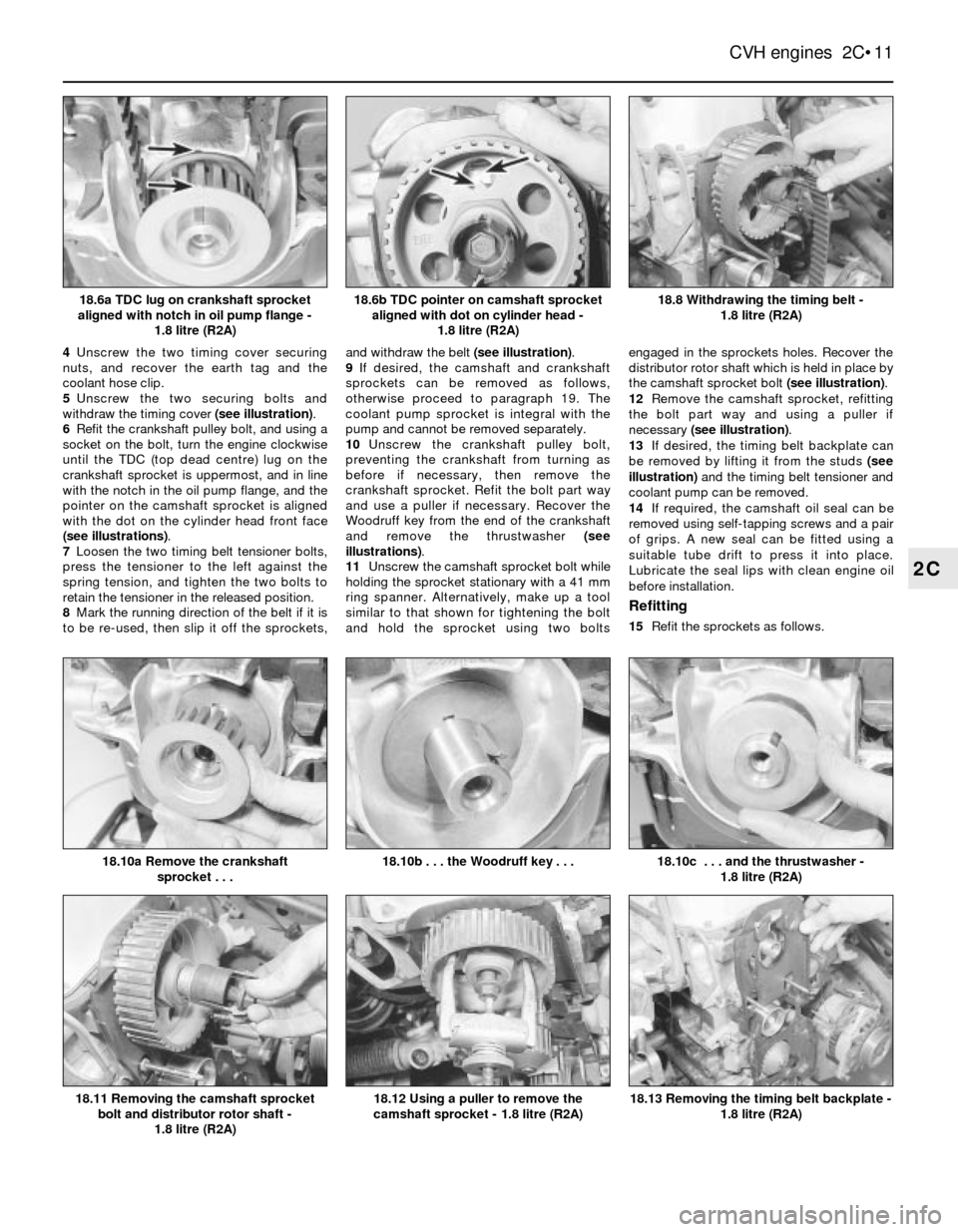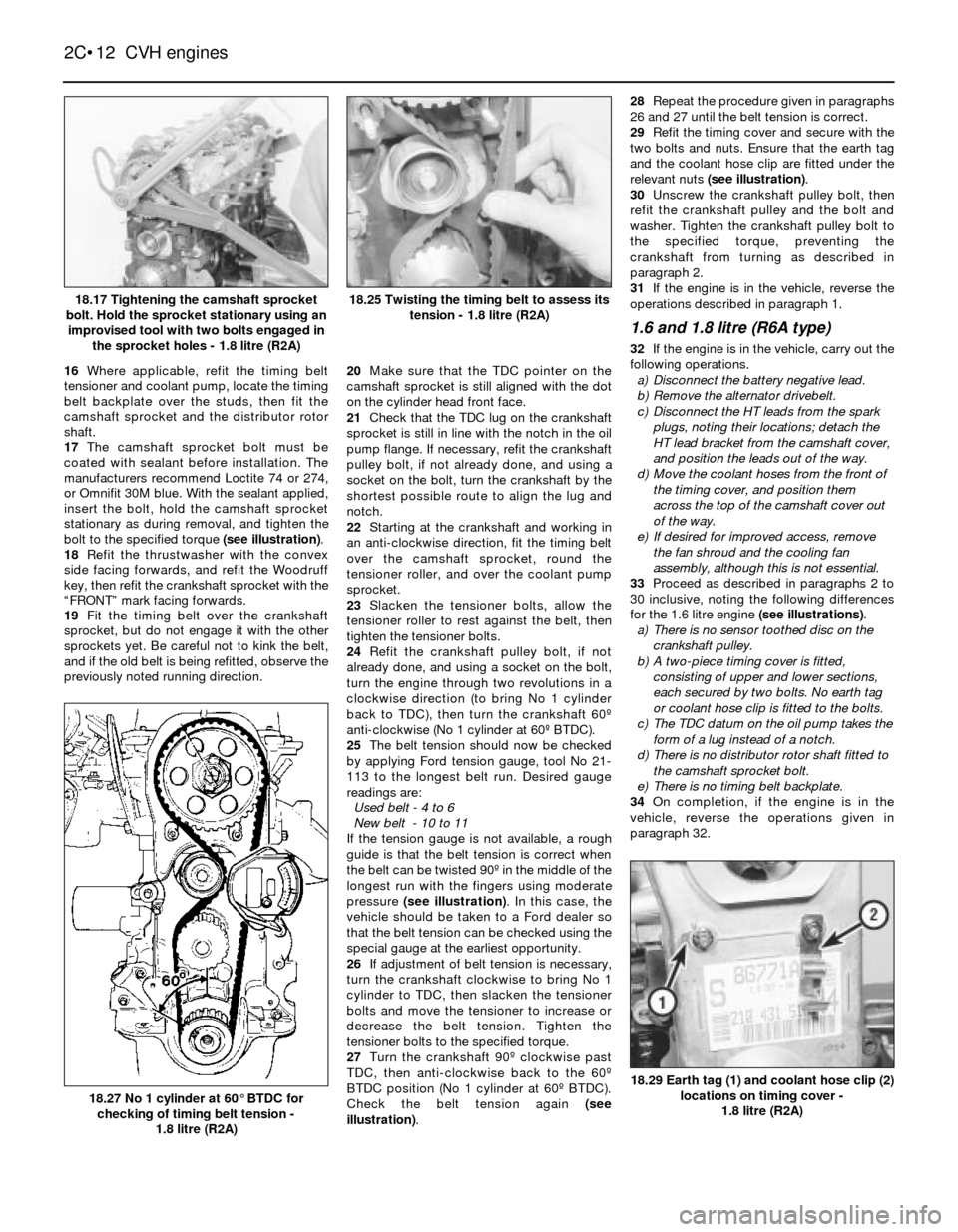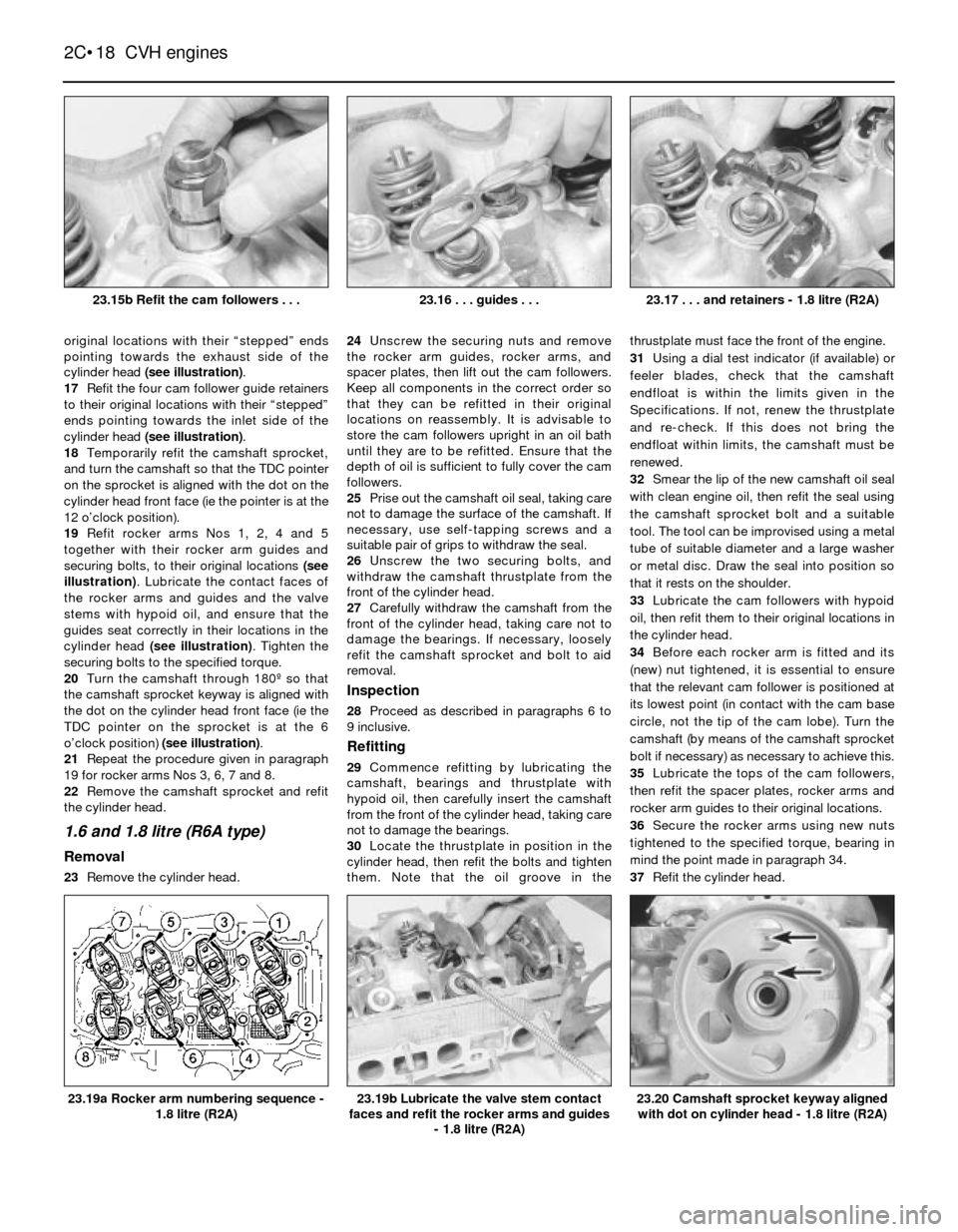clock FORD SIERRA 1992 2.G CVH Engines Workshop Manual
[x] Cancel search | Manufacturer: FORD, Model Year: 1992, Model line: SIERRA, Model: FORD SIERRA 1992 2.GPages: 24, PDF Size: 1.09 MB
Page 11 of 24

4Unscrew the two timing cover securing
nuts, and recover the earth tag and the
coolant hose clip.
5Unscrew the two securing bolts and
withdraw the timing cover (see illustration).
6Refit the crankshaft pulley bolt, and using a
socket on the bolt, turn the engine clockwise
until the TDC (top dead centre) lug on the
crankshaft sprocket is uppermost, and in line
with the notch in the oil pump flange, and the
pointer on the camshaft sprocket is aligned
with the dot on the cylinder head front face
(see illustrations).
7Loosen the two timing belt tensioner bolts,
press the tensioner to the left against the
spring tension, and tighten the two bolts to
retain the tensioner in the released position.
8Mark the running direction of the belt if it is
to be re-used, then slip it off the sprockets,and withdraw the belt (see illustration).
9If desired, the camshaft and crankshaft
sprockets can be removed as follows,
otherwise proceed to paragraph 19. The
coolant pump sprocket is integral with the
pump and cannot be removed separately.
10Unscrew the crankshaft pulley bolt,
preventing the crankshaft from turning as
before if necessary, then remove the
crankshaft sprocket. Refit the bolt part way
and use a puller if necessary. Recover the
Woodruff key from the end of the crankshaft
and remove the thrustwasher (see
illustrations).
11Unscrew the camshaft sprocket bolt while
holding the sprocket stationary with a 41 mm
ring spanner. Alternatively, make up a tool
similar to that shown for tightening the bolt
and hold the sprocket using two boltsengaged in the sprockets holes. Recover the
distributor rotor shaft which is held in place by
the camshaft sprocket bolt (see illustration).
12Remove the camshaft sprocket, refitting
the bolt part way and using a puller if
necessary (see illustration).
13If desired, the timing belt backplate can
be removed by lifting it from the studs (see
illustration)and the timing belt tensioner and
coolant pump can be removed.
14If required, the camshaft oil seal can be
removed using self-tapping screws and a pair
of grips. A new seal can be fitted using a
suitable tube drift to press it into place.
Lubricate the seal lips with clean engine oil
before installation.
Refitting
15Refit the sprockets as follows.
CVH engines 2C•11
2C
18.8 Withdrawing the timing belt -
1.8 litre (R2A)
18.13 Removing the timing belt backplate -
1.8 litre (R2A)18.12 Using a puller to remove the
camshaft sprocket - 1.8 litre (R2A)18.11 Removing the camshaft sprocket
bolt and distributor rotor shaft -
1.8 litre (R2A)
18.10c . . . and the thrustwasher -
1.8 litre (R2A)18.10b . . . the Woodruff key . . .18.10a Remove the crankshaft
sprocket . . .
18.6b TDC pointer on camshaft sprocket
aligned with dot on cylinder head -
1.8 litre (R2A)18.6a TDC lug on crankshaft sprocket
aligned with notch in oil pump flange -
1.8 litre (R2A)
Page 12 of 24

16Where applicable, refit the timing belt
tensioner and coolant pump, locate the timing
belt backplate over the studs, then fit the
camshaft sprocket and the distributor rotor
shaft.
17The camshaft sprocket bolt must be
coated with sealant before installation. The
manufacturers recommend Loctite 74 or 274,
or Omnifit 30M blue. With the sealant applied,
insert the bolt, hold the camshaft sprocket
stationary as during removal, and tighten the
bolt to the specified torque (see illustration).
18Refit the thrustwasher with the convex
side facing forwards, and refit the Woodruff
key, then refit the crankshaft sprocket with the
“FRONT” mark facing forwards.
19Fit the timing belt over the crankshaft
sprocket, but do not engage it with the other
sprockets yet. Be careful not to kink the belt,
and if the old belt is being refitted, observe the
previously noted running direction.20Make sure that the TDC pointer on the
camshaft sprocket is still aligned with the dot
on the cylinder head front face.
21Check that the TDC lug on the crankshaft
sprocket is still in line with the notch in the oil
pump flange. If necessary, refit the crankshaft
pulley bolt, if not already done, and using a
socket on the bolt, turn the crankshaft by the
shortest possible route to align the lug and
notch.
22Starting at the crankshaft and working in
an anti-clockwise direction, fit the timing belt
over the camshaft sprocket, round the
tensioner roller, and over the coolant pump
sprocket.
23Slacken the tensioner bolts, allow the
tensioner roller to rest against the belt, then
tighten the tensioner bolts.
24Refit the crankshaft pulley bolt, if not
already done, and using a socket on the bolt,
turn the engine through two revolutions in a
clockwise direction (to bring No 1 cylinder
back to TDC), then turn the crankshaft 60º
anti-clockwise (No 1 cylinder at 60º BTDC).
25The belt tension should now be checked
by applying Ford tension gauge, tool No 21-
113 to the longest belt run. Desired gauge
readings are:
Used belt - 4 to 6
New belt - 10 to 11
If the tension gauge is not available, a rough
guide is that the belt tension is correct when
the belt can be twisted 90º in the middle of the
longest run with the fingers using moderate
pressure (see illustration). In this case, the
vehicle should be taken to a Ford dealer so
that the belt tension can be checked using the
special gauge at the earliest opportunity.
26If adjustment of belt tension is necessary,
turn the crankshaft clockwise to bring No 1
cylinder to TDC, then slacken the tensioner
bolts and move the tensioner to increase or
decrease the belt tension. Tighten the
tensioner bolts to the specified torque.
27Turn the crankshaft 90º clockwise past
TDC, then anti-clockwise back to the 60º
BTDC position (No 1 cylinder at 60º BTDC).
Check the belt tension again (see
illustration).28Repeat the procedure given in paragraphs
26 and 27 until the belt tension is correct.
29Refit the timing cover and secure with the
two bolts and nuts. Ensure that the earth tag
and the coolant hose clip are fitted under the
relevant nuts (see illustration).
30Unscrew the crankshaft pulley bolt, then
refit the crankshaft pulley and the bolt and
washer. Tighten the crankshaft pulley bolt to
the specified torque, preventing the
crankshaft from turning as described in
paragraph 2.
31If the engine is in the vehicle, reverse the
operations described in paragraph 1.
1.6 and 1.8 litre (R6A type)
32If the engine is in the vehicle, carry out the
following operations.
a)Disconnect the battery negative lead.
b)Remove the alternator drivebelt.
c)Disconnect the HT leads from the spark
plugs, noting their locations; detach the
HT lead bracket from the camshaft cover,
and position the leads out of the way.
d)Move the coolant hoses from the front of
the timing cover, and position them
across the top of the camshaft cover out
of the way.
e)If desired for improved access, remove
the fan shroud and the cooling fan
assembly, although this is not essential.
33Proceed as described in paragraphs 2 to
30 inclusive, noting the following differences
for the 1.6 litre engine (see illustrations).
a)There is no sensor toothed disc on the
crankshaft pulley.
b)A two-piece timing cover is fitted,
consisting of upper and lower sections,
each secured by two bolts. No earth tag
or coolant hose clip is fitted to the bolts.
c)The TDC datum on the oil pump takes the
form of a lug instead of a notch.
d)There is no distributor rotor shaft fitted to
the camshaft sprocket bolt.
e)There is no timing belt backplate.
34On completion, if the engine is in the
vehicle, reverse the operations given in
paragraph 32.
2C•12CVH engines
18.17 Tightening the camshaft sprocket
bolt. Hold the sprocket stationary using an
improvised tool with two bolts engaged in
the sprocket holes - 1.8 litre (R2A)
18.27 No 1 cylinder at 60°BTDC for
checking of timing belt tension -
1.8 litre (R2A)
18.29 Earth tag (1) and coolant hose clip (2)
locations on timing cover -
1.8 litre (R2A)
18.25 Twisting the timing belt to assess its
tension - 1.8 litre (R2A)
Page 18 of 24

original locations with their “stepped” ends
pointing towards the exhaust side of the
cylinder head (see illustration).
17Refit the four cam follower guide retainers
to their original locations with their “stepped”
ends pointing towards the inlet side of the
cylinder head (see illustration).
18Temporarily refit the camshaft sprocket,
and turn the camshaft so that the TDC pointer
on the sprocket is aligned with the dot on the
cylinder head front face (ie the pointer is at the
12 o’clock position).
19Refit rocker arms Nos 1, 2, 4 and 5
together with their rocker arm guides and
securing bolts, to their original locations (see
illustration). Lubricate the contact faces of
the rocker arms and guides and the valve
stems with hypoid oil, and ensure that the
guides seat correctly in their locations in the
cylinder head (see illustration). Tighten the
securing bolts to the specified torque.
20Turn the camshaft through 180º so that
the camshaft sprocket keyway is aligned with
the dot on the cylinder head front face (ie the
TDC pointer on the sprocket is at the 6
o’clock position) (see illustration).
21Repeat the procedure given in paragraph
19 for rocker arms Nos 3, 6, 7 and 8.
22Remove the camshaft sprocket and refit
the cylinder head.
1.6 and 1.8 litre (R6A type)
Removal
23Remove the cylinder head. 24Unscrew the securing nuts and remove
the rocker arm guides, rocker arms, and
spacer plates, then lift out the cam followers.
Keep all components in the correct order so
that they can be refitted in their original
locations on reassembly. It is advisable to
store the cam followers upright in an oil bath
until they are to be refitted. Ensure that the
depth of oil is sufficient to fully cover the cam
followers.
25Prise out the camshaft oil seal, taking care
not to damage the surface of the camshaft. If
necessary, use self-tapping screws and a
suitable pair of grips to withdraw the seal.
26Unscrew the two securing bolts, and
withdraw the camshaft thrustplate from the
front of the cylinder head.
27Carefully withdraw the camshaft from the
front of the cylinder head, taking care not to
damage the bearings. If necessary, loosely
refit the camshaft sprocket and bolt to aid
removal.
Inspection
28Proceed as described in paragraphs 6 to
9 inclusive.
Refitting
29Commence refitting by lubricating the
camshaft, bearings and thrustplate with
hypoid oil, then carefully insert the camshaft
from the front of the cylinder head, taking care
not to damage the bearings.
30Locate the thrustplate in position in the
cylinder head, then refit the bolts and tighten
them. Note that the oil groove in thethrustplate must face the front of the engine.
31Using a dial test indicator (if available) or
feeler blades, check that the camshaft
endfloat is within the limits given in the
Specifications. If not, renew the thrustplate
and re-check. If this does not bring the
endfloat within limits, the camshaft must be
renewed.
32Smear the lip of the new camshaft oil seal
with clean engine oil, then refit the seal using
the camshaft sprocket bolt and a suitable
tool. The tool can be improvised using a metal
tube of suitable diameter and a large washer
or metal disc. Draw the seal into position so
that it rests on the shoulder.
33Lubricate the cam followers with hypoid
oil, then refit them to their original locations in
the cylinder head.
34Before each rocker arm is fitted and its
(new) nut tightened, it is essential to ensure
that the relevant cam follower is positioned at
its lowest point (in contact with the cam base
circle, not the tip of the cam lobe). Turn the
camshaft (by means of the camshaft sprocket
bolt if necessary) as necessary to achieve this.
35Lubricate the tops of the cam followers,
then refit the spacer plates, rocker arms and
rocker arm guides to their original locations.
36Secure the rocker arms using new nuts
tightened to the specified torque, bearing in
mind the point made in paragraph 34.
37Refit the cylinder head.
2C•18CVH engines
23.17 . . . and retainers - 1.8 litre (R2A)
23.20 Camshaft sprocket keyway aligned
with dot on cylinder head - 1.8 litre (R2A)23.19b Lubricate the valve stem contact
faces and refit the rocker arms and guides
- 1.8 litre (R2A)23.19a Rocker arm numbering sequence -
1.8 litre (R2A)
23.16 . . . guides . . .23.15b Refit the cam followers . . .